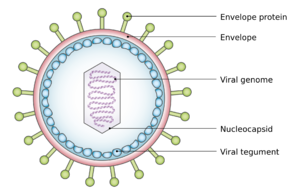Epstein-Barr virus (EBV) and EBV-associated lymphomas: Difference between revisions
No edit summary |
|||
| Line 30: | Line 30: | ||
<br> The repeated citation works like this, with a back slash.<ref name=aa/> | <br> The repeated citation works like this, with a back slash.<ref name=aa/> | ||
== | ==Latency Patterns of EBV Infection== | ||
Revision as of 06:33, 7 April 2021
By Yangyang Liu (Kenyon '23)
Introduction

Epstein-Barr virus (EBV), formally called Human gammaherpesvirus 4, are a group within the Lymphocryptovirus genus of the Herpesviridae family. EBVise double-stranded DNA viruses that use RNA polymerase for mRNA synthesis based on their negative-strand as the template. EBV Infection occurs through oral transfer of saliva as well as genital secretions and more than 90% of normal adults would gain adaptive immunity after their primary EBV infection. The remaining EBV virus would remain in an asymptomatic latent state for a lifetime within resting B-cells, and a healthy adult with a working immune system would be able to contain the infection with the help of their cytotoxic T cells (CTLs), lymphocyte CD8+ and CD4+, and natural killer (NK) cells [1]. Only a small subset encountering life-threatening diseases due to them unable in maintaining the virus within the latent state. In an uncontrolled situation, EBV-driven lymphoproliferative disorders and lymphomas could develop with the patients. EBV-associated cancers are a common example among the ~15% of all human cancers involving a virus infection [2].
Some of the most well-known illnesses that are caused by EBV are mononucleosis, Burkitt’s lymphoma, Hodgkin’s lymphoma, non-Hodgkin lymphoma, post-transplant lymphoproliferative disease (PTLD), nasopharyngeal carcinoma, and numerous other types of cancer [3]. This page investigates how different latency patterns of EBV infection could lead to numerous types of lymphoma. It also addresses the role of EBV in rare EBV-associated NK-cell lymphoproliferative diseases.
Overall paper length should be 3,000 words, with at least 3 figures. Include some current research in each topic, with at least one figure showing data per section.
At right is a sample image insertion. It works for any image uploaded anywhere to MicrobeWiki.
The insertion code consists of:
Double brackets: [[
Filename: PHIL_1181_lores.jpg
Thumbnail status: |thumb|
Pixel size: |300px|
Placement on page: |right|
Legend/credit: Electron micrograph of the Ebola Zaire virus. This was the first photo ever taken of the virus, on 10/13/1976. By Dr. F.A. Murphy, now at U.C. Davis, then at the CDC. Every image requires a link to the source.
Closed double brackets: ]]
Other examples:
Bold
Italic
Subscript: H2O
Superscript: Fe3+
Introduce the topic of your paper. What is your research question? What experiments have addressed your question? Applications for medicine and/or environment?
Sample citations: [4]
[5]
A citation code consists of a hyperlinked reference within "ref" begin and end codes.
To repeat the citation for other statements, the reference needs to have a names: "<ref name=aa>"
The repeated citation works like this, with a back slash.[4]
Latency Patterns of EBV Infection
Section 2
Section 3
Section 4
Conclusion
See Also
- sample links that needs to be updated later
Stomach
Small Intestine
The Hologenome Theory of Evolution
Microbes and Animal Behavior
Intestinal Microflora and Antibiotic Resistance
References
- ↑ https://www.ncbi.nlm.nih.gov/pmc/articles/PMC3305910/#:~:text=Epstein%2DBarr%20virus%20(EBV),driven%20lymphoproliferative%20disorders%20and%20lymphomas
- ↑ https://onlinelibrary.wiley.com/doi/abs/10.1002/rmv.456
- ↑ https://www.ncbi.nlm.nih.gov/pmc/articles/PMC3415781/
- ↑ 4.0 4.1 Hodgkin, J. and Partridge, F.A. "Caenorhabditis elegans meets microsporidia: the nematode killers from Paris." 2008. PLoS Biology 6:2634-2637.
- ↑ Bartlett et al.: Oncolytic viruses as therapeutic cancer vaccines. Molecular Cancer 2013 12:103.
Authored for BIOL 238 Microbiology, taught by Joan Slonczewski, 2021, Kenyon College.
